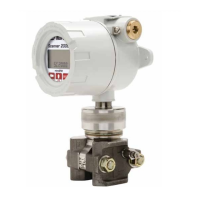C-14
Appendix C Scanner
®
2000 microEFM
5. Set the XD-SCALE parameter. This setting denes the input values from the transducer block (input
range of sensor) that correspond to 0% and 100% values in AI function block calculations. When the
desired output is the measured variable (L_TYPE is set to direct), set the XD_SCALE to represent the
operating range of the sensor. When an inferred measurement is made based on the sensor measurement
(L-TYPE is set to indirect), set the XD_SCALE to represent the operating range that the sensor will see in
the process.
6. Set the OUT-SCALE settings in accordance with the XD-SCALE 0 and 100% points. This setting denes
the output values corresponding to 0% and 100% values in the calculation inside the AI function blocks.
a. If scaling is not required, enter the same values that were entered for the XD-SCALE parameter in the
EU _100 and EU_0 subparameter elds.
b. If the measured or calculated value must be scaled to provide the desired output (and the L-TYPE
parameter is set to indirect), enter the values that correspond with 0% and 100% of the output range in
the EU _0 and EU_100 subparameter elds, and enter the appropriate output unit in the UNITS_IN-
DEX eld.
7. Congure alarms, if desired.
a. Set value limits for high (HI_LIM) alarms.
b. Set value limits for high high (HI_HI_LIM) alarms.
c. Set value limits for low (LO_LIM) alarms.
d. Set value limits for low low (LO_LO_LIM) alarms.
e. Set a priority level for each alarm, as appropriate, by selecting a numeric code from the ve priority
levels supported:
0 = alarm not used
1 = alarm is recognized by the network, but is not reported to the user
2 = alarm is reported to the user
3-7 = advisory alarms of increasing priority, with 7 being the highest priority
8-15 = critical alarms of increasing priority with 15 being the highest priority
8. Repeat steps 1 to 7 for each of the other AI blocks, as required.
9. Change the mode (Target) of each AI block to Auto.
Control Loop Design
When the AI blocks have been congured, the user may proceed with linking function blocks to build a
process control loop and conguring scheduling of block executions. These activities are not specic to the
Scanner 2000 and are outside the scope of this manual. See the host manual or conguration tool manual for
assistance.
NOTE The maximum time required to execute a Scanner 2000 AI block is 30 ms.
When control loops are congured, the network conguration must be downloaded to the network. See the
host manual or the conguration tool manual for instructions.

